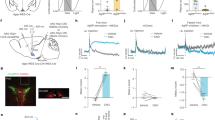Abstract
Current studies show that type II glucocorticoid receptor (GR) stimulation during recurring insulin-induced hypoglycemia (RIIH) results in diminished hypoglycemic activation of neurons in discrete CNS metabolic structures, namely the lateral hypothalamic area (LHA), hypothalamic paraventricular (PVH) and dorsomedial (DMH) nuclei, and nucleus of the solitary tract (NTS). The present work utilized immunofluorescence histochemistry to evaluate the reactivity of GR-expressing neurons in characterized hypothalamic, thalamic, and hindbrain metabolic structures to glucoprivation, and to determine if antecedent hypoglycemic stimulation of central GR decreases Fos protein expression by these neurons. Groups of adult male rats were injected subcutaneously with one or four doses of the intermediate-acting insulin, Humulin NPH, on as many days, while controls received diluent only. Rats injected with four doses of insulin were pretreated by intracerebroventricular administration of the selective GR antagonist, CP-475222, or vehicle alone prior to insulin doses 1–3. All animals were sacrificed by trancardial perfusion 2 h after injections on day four of the study. Mean numbers of GR-immunoreactive (-ir) neurons did not differ between groups injected with diluent versus one dose of insulin in each structure evaluated, but were significantly elevated above baseline on the fourth day of RIIH in the LHA and DMH, but not the PVH, VMH, ARC, thalamic paraventricular (PVT), or NTS. Counts of GR-ir-positive neurons in each site were similar between groups treated with CP-475222 or vehicle icv during RIIH. While mean numbers of GR-plus Fos-ir neurons in the PVH, DMH, LHA, and NTS, but not the PVT were significantly elevated after one dose of NPH, this increase was abolished in each site by RIIH. Pharmacological antagonism of central GR during antecedent hypoglycemia prevented RIIH-associated habituation of Fos colabeling of GR-expressing neurons in the PVH, DMH, and LHA. These data show that RIIH increases nuclear immunolabeling for GR in discrete CNS metabolic structures, evidence that recurring metabolic stress may amplify receptor-mediated genomic regulatory function in local neurons. The results also demonstrate that GR-containing neurons in the LHA, DMH, PVH, and NTS react to hypoglycemia by induction of the Fos stimulus-transcription cascade, and that precedent stimulation of central GR is critical for RIIH-associated habituation of this functional response in the former three sites.




Similar content being viewed by others
References
Ahima RS, Harlan RE (1990) Charting of type II glucocorticoid receptor-like immunoreactivity in the rat central nervous system. Neuroscience 39:147–152
Boyle PJ, Cryer PE (1991) Growth hormone, cortisol, or both are involved in defense against, but are not critical to recovery from, hypoglycemia. Am J Physiol 260:E395–402
Cintra A, Zoli M, Rosen L, Agnati LF, Okret S, Wikstrom AC, Gustafsson JA, Fuxe K (1994) Mapping and computer assisted morphometry and microdensitometry of glucocorticoid receptor immunoreactive neurons and glial cells in the rat central nervous system. Neuroscience 62:843–897
Cryer PE (1982) Hypoglycemic glucose counterregulation in patients with insulin-dependent diabetes mellitus. J Lab Clin Med 99:451–6
Cryer PE (1997) Hierarchy of physiological responses to hypoglycemia: relevance to clinical hypoglycemia in type I (insulin dependent) diabetes mellitus. Horm Metab Res 29:92–6
Cryer PE, Polonsky KS (1997) Glucose homeostasis and hypoglycemia. In: Wilson JD, Foster DW (eds) Williams textbook of endocrinology, 9th edn. WB Saunders Co, Philadelphia, pp 939–971
Davis M, Shamoon H (1991) Counterregulatory adaptation to recurrent hypoglycemia in normal humans. J Clin Endocrinol Metab 73:995–1001
Drouin J, Sun YL, Tremblay S, Lavender P, Schmidt TJ, deLean A, Nemer M (1992) Homodimer formation is rate limiting for high affinity binding by the glucocorticoid receptor. Mol Endocrinol 6:1299–1309
Kale AY, Paranjape SA, Briski KP (2006) Intracerebroventricular administration of the nonsteroidal glucocorticoid receptor antagonist, CP472555, prevents exacerbated hypoglycemia during repeated insulin administration. Neuroscience, in press
Melia KR, Ryabinin AE, Schroeder R, Bloom FE, Wilson MC (1994) Induction and habituation of immediate early gene expression in rat brain by acute and repeated restraint stress. J Neurosci 14:5929–5938
Mitrakou A, Ryan C, Veneman T, Mokan M, Jenssen T, Kiss I, Durrant J, Cryer P, Gerich J (1991) Hierarchy of glycemic thresholds for counterregulatory hormone secretion, symptoms, and cerebral dysfunction. Am J Physiol 260:E67–74
Morgan BP, Liu KC, Dalvie DK, Swick AG, Hargrove DM, Wilson TC, Janet A, Moynihan LS, Rushing MA, Woodworth GF, Li J, Trilles RV, Yang X, Harper KW, Carroll RS, Martin KA, Nardone NA, O’Donnell JP, Faletto MB, Vage C, Soliman V (2004) Discovery of potent, non-steroidal and highly selective glucocorticoid receptor antagonists with anti-obesity activity. Lett Drug Des Discov 1:1–5
Morimoto M, Norita N, Ozawa H, Yokoyama K, Kawata M (1996) Distribution of glucocorticoid receptor immunoreactivity and mRNA in the rat brain: an immunohistochemical and in situ hybridization study. Neurosci Res 26:235–269
Pacak K, Palkovits M (2001) Stressor specificity of central neuroendocrine responses: implications for stress-related disorders. Endocr Rev 22:502–548
Paranjape SA, Briski KP (2005) Recurrent insulin-induced hypoglycemia causes site-specific patterns of habituation or amplification of CNS neuronal genomic activation. Neuroscience 130:957–970
Stamp J, Herbert J (2001) Corticosterone modulates autonomic responses and adaptation of central immediate-early gene expression in repeated restraint stress. Neuroscience 107:465–479
Umemoto S, Noguchi K, Kawai Y, Senba (1994) Repeated stress induces the subsequent stress-induced expression of Fos in rat brain. Neurosci Lett 167:101–104
Watanabe Y, Stone E, McEwen BS (1994) Induction and habituation of cFos and zif/268 by acute and repeated stressors. Neuro Rep 5:1321–1324
Acknowledgments
This work was supported by an Innovative Research Grant from the Juvenile Diabetes Research Foundation. The authors wish to express their gratitude to Dr. Andrew Swick, Pfizer, Inc., for the generous gift of CP-472555.
Author information
Authors and Affiliations
Corresponding author
Rights and permissions
About this article
Cite this article
Kale, A.Y., Paranjape, S.A. & Briski, K.P. Site-specific habituation of insulin-induced hypoglycemic induction of Fos immunoreactivity in glucocorticoid receptor: immunopositive neurons in the male rat brain. Exp Brain Res 176, 260–266 (2007). https://doi.org/10.1007/s00221-006-0614-4
Received:
Accepted:
Published:
Issue Date:
DOI: https://doi.org/10.1007/s00221-006-0614-4




